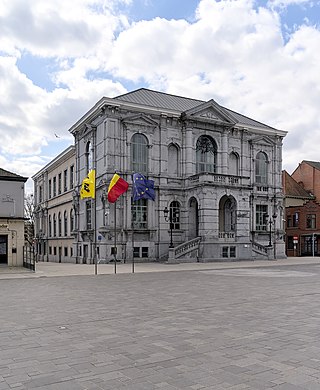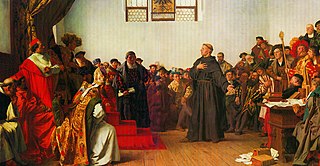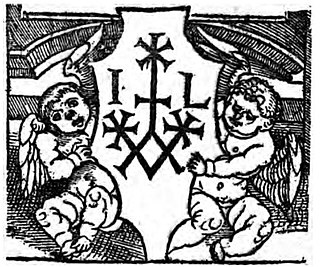
Jan van Essen and Hendrik Vos or Voes, were the first two Lutherans executed by the Council of Brabant for their adherence to Reformation doctrine. They were burned at the stake in Brussels on 1 July 1523. [1]

Jan van Essen and Hendrik Vos or Voes, were the first two Lutherans executed by the Council of Brabant for their adherence to Reformation doctrine. They were burned at the stake in Brussels on 1 July 1523. [1]
Essen and Vos were Augustinian monks of Saint Augustine's Monastery in Antwerp. When in 1522 all the monks there publicly professed Lutheran doctrine, the Bishop of Cambrai had them all arrested and imprisoned in Vilvoorde, where they were interrogated by the Flemish inquisitor Jacob van Hoogstraten, who ordinarily resided in Cologne, and some dependably Catholic professors. When the monks realized that they risked being burned alive if they did not recant, all except three — Jan van Essen, Hendrik Vos, and Lampertus Thorn — recanted. The recanting monks were released but were not returned to the monastery, which instead was declared defiled and soon demolished. [2]
Van Essen, Vos, and Thorn, still held in custody, were questioned again by the ecclesiastical inquisition court, but they refused to recant. They were then handed over to the secular court and sentenced to death. They were taken to Brussels and held until the appointed day of execution on 1 July 1523. New attempts were made meanwhile to get them to renounce. Vos was brought first to the inquisitors, but he refused to recant. Van Essen also refused to renounce Lutheranism. Thorn asked for an additional four-day period to study the scriptures with respect to his views, and thus he was not executed then with van Essen and Vos. Van Essen and Vos were summarily delivered to the executioner, brought to the marketplace in Brussels, and burned alive. For some reason, the charges against them were not read aloud as was the established practice. It has been conjectured that the authorities were concerned that hearing the charges might cause Lutheran ideas to spread among the public witnesses or that the ideas were already there and would ignite a protest. [3] Thorn was spared in prison for an additional five years, dying in prison in 1528. [4]
On learning of the execution of van Essen and Vos, Martin Luther wrote what is thought to be his first hymn, "Ein neues Lied wir heben an" [5] ("A new song we raise") which was printed in the Erfurt Enchiridion of 1524. This is generally known in English as John C. Messenger's translation by the first line and title "Flung to the Heedless Winds" and sung to the tune of Ibstone composed in 1875 by Maria C. Tiddeman or to that of Denby composed in 1904 by Charles J. Dale. [6]

Pope Adrian VI, born Adriaan Florensz Boeyens, was head of the Catholic Church and ruler of the Papal States from 9 January 1522 until his death on 14 September 1523. The only Dutchman to become pope, he was the last non-Italian pope until the Polish John Paul II 455 years later.

Year 1523 (MDXXIII) was a common year starting on Thursday of the Julian calendar.

Vilvoorde is a Belgian municipality in the Flemish province of Flemish Brabant. The municipality comprises the city of Vilvoorde proper with its two outlying quarters of Koningslo and Houtem and the small town of Peutie. The nickname for inhabitants of Vilvoorde is Pjeirefretters because horse meat is a beloved food in Vilvoorde.

Robert Barnes was an English reformer and martyr.

Rogier van der Weyden or Roger de la Pasture was an early Netherlandish painter whose surviving works consist mainly of religious triptychs, altarpieces, and commissioned single and diptych portraits. He was highly successful in his lifetime; his paintings were exported to Italy and Spain, and he received commissions from, amongst others, Philip the Good, Netherlandish nobility, and foreign princes. By the latter half of the 15th century, he had eclipsed Jan van Eyck in popularity. However his fame lasted only until the 17th century, and largely due to changing taste, he was almost totally forgotten by the mid-18th century. His reputation was slowly rebuilt during the following 200 years; today he is known, with Robert Campin and van Eyck, as the third of the three great Early Flemish artists, and widely as the most influential Northern painter of the 15th century.

The Diet of Worms of 1521 was an imperial diet of the Holy Roman Empire called by Emperor Charles V and conducted in the Imperial Free City of Worms. Martin Luther was summoned to the Diet in order to renounce or reaffirm his views in response to a Papal bull of Pope Leo X. In answer to questioning, he defended these views and refused to recant them. At the end of the Diet, the Emperor issued the Edict of Worms, a decree which condemned Luther as "a notorious heretic" and banned citizens of the Empire from propagating his ideas. Although the Protestant Reformation is usually considered to have begun in 1517, the edict signals the first overt schism.

Martin Luther was a German priest, theologian, author, hymnwriter, professor, and Augustinian friar. He was the seminal figure of the Protestant Reformation, and his theological beliefs form the basis of Lutheranism.
Jacob van Hoogstraten was a Flemish Dominican theologian and controversialist.

Jan Jansz de Bakker van Woerden was a Roman Catholic priest who was the first priest in the Northern Netherlands to be put to death as a direct result of his beliefs.
Vos is a Dutch surname meaning "fox". With 30,279 people, it was the 15th most common surname in the Netherlands in 2007. Notable people with this name include:

Jacobus Latomus was a Catholic Flemish theologian, a distinguished member of the Faculty of Theology at the University of Leuven. Latomus was a theological adviser to the Inquisition, and his exchange with William Tyndale is particularly noted. The general focus of his academic work centered on opposing Martin Luther and the Protestant Reformation, supporting the papacy and the hierarchy of the Catholic Church. Etymology: Latinized Latomus = Masson from Greek lā-tómos 'stone-cutter, quarryman', thus 'mason'.
Eligius Pruystinck or Looi de Schaliedekker was an Antwerp slater who became the leader of a radical Protestant faction named Loists after him.

The family of de Pannemaeker or de Pannemaker were tapestry weavers from the Southern Netherlands, more or less equivalent to modern-day Belgium. Pieter de Pannemaeker, working from Brussels, was a celebrated weaver who, for European royalty, created tapestries resplendent with gold and silver threads, and expensive fine silks and woollen items. In 1520, Pieter de Pannemaeker commissioned the artist Bernard van Orley to make tapestry cartoons for his workshop. A surviving fragment depicts the Allegory of the Four Winds. Pannemaeker was court weaver to Margaret of Austria, Regent of the Southern Netherlands, who commissioned the Passion in four parts, and in 1523, she ordered an imposing dais made up of three tapestries, which later featured in the abdication ceremony of Emperor Charles V.
The following outline is provided as an overview of and topical guide to Protestantism:

The Erfurt Enchiridion is the second Lutheran hymnal. It appeared in 1524 in Erfurt in two competing editions. One of them contains 26 songs, the other 25, 18 of them by Martin Luther, others by Elisabeth Cruciger, Erhard Hegenwald, Justus Jonas and Paul Speratus. While the songs of the Enchiridion could be used in churches, they were intended primarily for singing elsewhere, such as at home, at court, and in guild meetings.

Ruard Tapper was a Dutch theologian of the Catholic Reformation, a chancellor of Leuven University, and an inquisitor.
Church music during the Reformation developed during the Protestant Reformation in two schools of thought, the regulative and normative principles of worship, based on reformers John Calvin and Martin Luther. They derived their concepts in response to the Catholic church music, which they found distracting and too ornate. Both principles also pursued use of the native tongue, either alongside or in place of liturgical Latin.

Jacob van Liesvelt or Jacob van Liesveldt, was a Flemish printer, publisher and bookseller. His printing press put out publications in a wide range of genres, including poetry by Anna Bijns, Roman Catholic literature, such as an anti-heresy decree, and publications that conflicted with Catholic teachings. He published the first complete Dutch translation of the Bible in 1526. It was largely based on Martin Luther's translation. He was eventually executed for publishing unauthorised versions of the Bible.